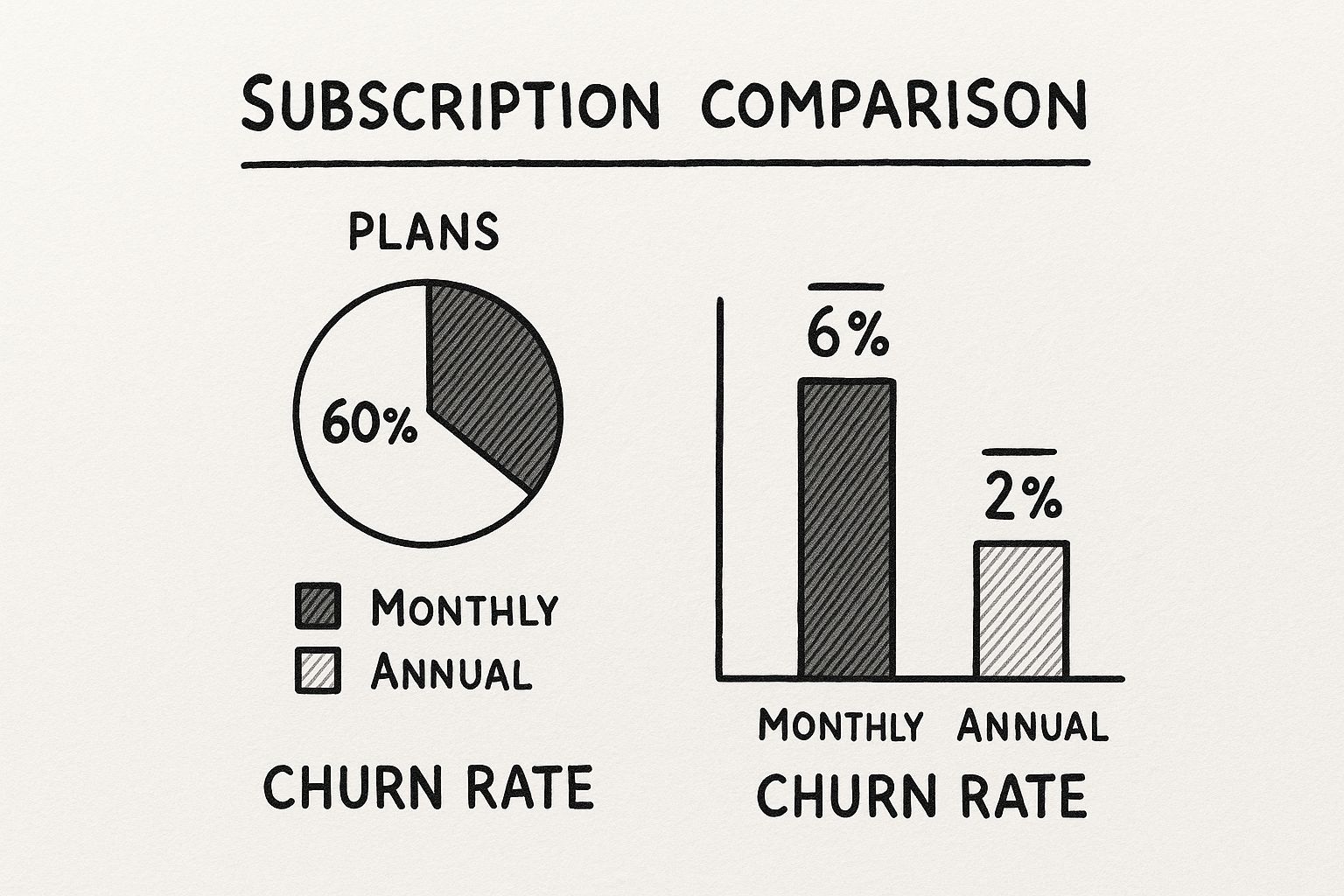August 19, 2025

Let’s face it, the traditional way of doing business—chasing one-off sales—is a grind. It’s a constant feast-or-famine cycle that can leave even the most seasoned entrepreneur feeling exhausted. One month you’re on top of the world, the next you’re scraping by.
Recurring revenue models offer a way out of that rollercoaster. Instead of focusing on single transactions, you build a system where customers pay you regularly—monthly or annually—for ongoing access to your products or services. It’s the difference between a freelance gig and a steady salary, providing a predictable stream of income you can count on.
That constant up-and-down of transactional sales doesn't just mess with your sleep; it makes it nearly impossible to plan for the future. How can you confidently hire a new team member, invest in better tools, or map out your growth when you have no idea what next quarter’s revenue will look like?
This is where recurring revenue changes the game. When you have a reliable income stream, you can forecast your finances with actual confidence. This stability isn't just a relief; it’s a strategic advantage that lets you make smart, long-term decisions instead of reactive, short-term gambles.
This move toward predictability isn't just a small trend—it's a massive shift in how we do business. We've entered what many call the "subscription economy," a world where consumers increasingly value access over ownership. Think Netflix, Spotify, or your favorite software tool.
This global movement from one-time transactions to ongoing payments is reshaping entire industries. It prioritizes customer relationships and consistent value delivery, making companies more resilient and valuable.
This model fundamentally changes your relationship with your customers. Your success is no longer about closing a single deal; it's about keeping your customers happy month after month. You’re not just selling a product; you’re building a loyal community that becomes the very foundation of your business.
The numbers are staggering. The subscription economy has skyrocketed by 435% since 2016 and is on track to hit $1.5 trillion by 2025. This isn't a fluke; it's a clear signal that investors and entrepreneurs see recurring revenue as the future. You can discover more insights about this economic shift and see what it means for businesses today.
In this guide, we'll give you a clear, actionable roadmap to these powerful models. We’ll break down the core concepts, help you find the right fit for your business, and show you how to build a more stable and profitable future.
If you're aiming to build a stable, predictable business, you need to get familiar with the different ways to generate recurring revenue. They all share the goal of creating consistent income, but each model works a little differently and is better suited for certain types of products or services. Think of them as different blueprints for building long-term customer relationships.
Let's walk through four of the most popular and effective models. By looking at how each one works with simple analogies and real-world examples, you'll get a clearer picture of which one could be the right fit for your business.
This is the one most people know. A subscription is a lot like your favorite magazine arriving in the mail every month. A customer pays a regular fee—monthly or annually—and in return, they get a product or service delivered to them over and over. This model is all about convenience and continuous value, removing the need for customers to think about making repeat purchases.
A perfect example is Dollar Shave Club. They took a simple, everyday product (razor blades) and turned it into a hassle-free service. Instead of running to the store, customers just get fresh blades delivered to their door. It’s a classic case of turning a one-off purchase into a long-term relationship. For more ideas on how companies nail this, check out these powerful subscription business model examples.
The chart below shows a common breakdown of monthly versus annual plans and reveals a key insight: longer commitments drastically reduce churn.

As you can see, even though monthly plans might seem like an easier sell, annual subscribers are 3x more likely to stick around. That’s a huge win for customer loyalty and long-term stability.
While subscriptions are often about receiving something, memberships are about gaining access. Think of it like joining a private country club or a premium gym. Your monthly fee doesn't just buy you a towel; it unlocks an exclusive space with trainers, classes, and a whole community of people with similar goals.
This model is built on a sense of belonging. Customers pay for access to a community, exclusive content, or special perks that outsiders can't get. It's less about a physical product and much more about the experience and the connections people make.
The real value of a membership isn’t just the content—it’s the community and exclusive access it provides. It turns customers from passive buyers into active members of a tribe.
For this model to work, the right foundation is key. Choosing from the best membership site platform options is like finding the perfect location for that exclusive gym—it sets the stage for everything else.
The freemium model is a bit like a "try before you buy" offer at a massive scale. You let people use a basic version of your product for free, hoping they'll love it enough to upgrade for the full, feature-packed experience. The strategy here is to get as many people in the door as possible, then convert a small fraction of them into paying customers.
Spotify has absolutely mastered this. Anyone can stream music with ads and some limitations. But if you want to skip the ads, download songs, and get full control, you’re constantly nudged to upgrade to their paid Premium plan. It’s an incredibly effective hook for digital products where the cost of serving a free user is relatively low.
Finally, there's the licensing model. This one is like renting a highly specialized piece of equipment instead of buying it. A customer pays a fee for the right to use a product—usually software or some form of intellectual property—for a set amount of time. They don't own it, but they have permission to use it as long as they keep paying.
Adobe Creative Cloud is the poster child for this model. Not too long ago, designers had to shell out a huge one-time cost for a program like Photoshop. Now, they pay a manageable monthly or annual fee to license the entire suite of Adobe's creative tools, complete with every update. This makes powerful software more affordable for users and gives Adobe a beautifully predictable revenue stream.
To help you see how these models stack up against each other, here's a quick comparison.
This table breaks down the four models we just covered, highlighting where they shine, their biggest perks, and the common hurdles you might face with each.
Each model offers a unique path to building a sustainable business. The key is to match the model to what you're offering and the kind of relationship you want to build with your customers.
Think of it this way: one-time sales are like catching lightning in a bottle. You get a brilliant flash of energy, but it's unpredictable and hard to repeat. A recurring revenue model, on the other hand, is like building a hydroelectric dam—it generates a steady, reliable current you can count on. For investors, the choice is almost always the dam.
This preference isn’t just a gut feeling; it’s grounded in fundamental principles of risk, growth, and long-term value.
Predictability is the ultimate currency for an investor. A business relying on traditional sales might have a fantastic quarter, but what about the next one? That kind of uncertainty makes it incredibly difficult to forecast performance, which is a classic high-risk scenario. Recurring revenue completely flips that script. By tracking a few key metrics, these businesses can project future income with a surprising degree of accuracy.
The real magic is in the metrics. They provide a clear window into a company's financial health and where it's headed. Instead of guessing, investors can look at concrete data points that tell a powerful story.
These metrics turn financial planning from a guessing game into a strategic exercise. A business can invest confidently in its own growth, knowing that a steady stream of income is already locked in. That stability is incredibly attractive to anyone looking to back a company for the long haul.
This predictability doesn't just lower risk; it sends a company's valuation soaring. According to John Warrillow, the author of The Automatic Customer, businesses with recurring revenue can fetch valuations up to eight times higher than similar companies built on single transactions. You can discover more about recurring revenue's impact and why it's so prized by investors.
For investors, predictable revenue isn't just a number—it's a signal of a healthy, sustainable business with a loyal customer base. It proves the company has built something people are willing to pay for again and again.

This loyalty is measured by another crucial metric: Customer Lifetime Value (CLV). Since customers in these models tend to stick around for much longer, their total worth to the business climbs significantly. A high CLV is a clear indicator of strong product-market fit and a resilient customer base, making the company a far more profitable—and much less risky—investment.
When you shift to a recurring revenue model, your definition of success changes. It’s no longer about individual transactions; it's about the long-term health and momentum of your customer base. To get a real read on how you're doing, you need to look beyond one-off sales and focus on a few key metrics that tell the whole story.
Think of these numbers as the instruments in a cockpit. They give you a real-time read on your altitude, speed, and fuel, so you can make smart adjustments to stay on course. Flying blind just isn't an option.

Let's start with the basics: Monthly Recurring Revenue (MRR) and Annual Recurring Revenue (ARR). These two metrics are the pulse of your business, showing you the predictable income you can count on every month and year from your active subscribers.
MRR isn't the same as total monthly revenue. It specifically filters out the noise of one-time purchases, giving you a stable baseline for financial planning. It’s the number that lets you breathe a little easier. ARR is simply your MRR multiplied by 12, offering that bigger-picture view of your company’s scale.
While MRR tells you what's coming in, the Customer Churn Rate shows you what's going out. Churn is the percentage of customers who cancel their subscription in a given period, and it's the silent killer of growth for many subscription businesses.
Picture your business as a bucket you're trying to fill with new customers. If that bucket is riddled with holes (churn), you'll spend all your time and money just trying to replace what you've lost, never actually getting ahead. A high churn rate is a treadmill you can’t get off of, especially since finding new customers almost always costs more than keeping the ones you have.
Plugging the leaks isn't just a defensive tactic—it's one of the most powerful growth levers you have. Even a small drop in your churn rate can have a massive impact on your bottom line over time.
Getting a handle on churn is non-negotiable. If you want some proven tactics to keep your members happy and subscribed, our guide on how to reduce churn rate is packed with strategies you can start using today.
So, how do you know if your growth is actually profitable? That’s where two final, intertwined metrics come into play: Customer Lifetime Value (CLV) and Customer Acquisition Cost (CAC).
The math here is simple but absolutely critical. For a sustainable business, your CLV must be significantly higher than your CAC. A good benchmark to shoot for is a CLV that’s at least three times your CAC. This ratio ensures that every new customer isn't just another number, but a genuinely profitable investment that fuels your company's future.
Picking a recurring revenue model isn’t about chasing the latest trend. It’s about finding the perfect match for what you actually do. A model that’s a home run for a software company could completely strike out for a community brand. The real secret is avoiding a fundamental mismatch between your product and how you charge for it.
To get it right, you really only need to answer three core questions. The answers will point you directly to a structure that’s not just profitable, but sustainable for the long haul.
First thing's first: what’s the core value you deliver day in and day out? A subscription model makes sense when you provide tangible, ongoing value—think of a software tool that solves a daily headache or a service that saves customers hours every single month.
But if your main draw is the sense of community, connection, and exclusive access, then a membership model is almost certainly your best bet. A content creator who has built a loyal following, for instance, will find that offering a private community and bonus content through a membership feels far more natural and valuable to their audience.
Next up, how do your customers want to interact with what you offer? Would they prefer to pay one flat fee for unlimited access, or does the idea of paying only for the features they use sound more appealing?
Getting this right is crucial. For anyone leaning toward a membership, knowing how to sell that sense of belonging is key. You can check out these modern strategies for selling gym memberships to see how this works in the real world.
Finally, let’s get real about what you and your team can handle. Each of these recurring revenue models places different demands on your time, technology, and resources.
A common mistake is choosing a model that your business isn't equipped to support. Be honest about your capacity to manage customer service, content creation, and community engagement before you commit.
A freemium model, for example, requires a robust product that can handle a massive number of non-paying users without crumbling. On the other hand, a membership model lives or dies by active community management. Keeping members happy is just as vital as signing them up; our guide on proven membership retention strategies is packed with insights to help you succeed long-term.
The global subscription economy was valued at a massive $492 billion in 2024 and is expected to rocket past $1.5 trillion by 2033. This shows just how much opportunity is out there. By thoughtfully aligning your core value, customer needs, and operational muscle, you can land on a model that not only works today but is built to grow with you.
Thinking about moving to a recurring revenue model can bring up a lot of questions. It’s a big shift, after all. It changes the entire dynamic of how you think about getting new customers, making sales, and building relationships.
Let's dive into some of the most common things business owners wonder about when they're considering this powerful change. Getting clear on these points early on will help you sidestep potential pitfalls and build a much stronger strategy right from the start.
Hands down, the toughest part is managing customer churn. With a one-time sale, the deal is done once the payment goes through. Here, your revenue depends entirely on keeping people happy enough to pay you again and again.
High churn is like trying to fill a leaky bucket. You're constantly scrambling to pour new customers in at the top just to make up for the ones dripping out the bottom. It forces a complete mental shift from obsessing over customer acquisition to obsessing over delivering continuous value and keeping your members engaged. It's not just about winning them over once; it's about re-earning their business every single month.
Absolutely. You'd be surprised how many traditional businesses can find a way to pivot. The trick is to pinpoint something in your business that delivers ongoing, repeatable value.
A marketing consultant who used to charge per project could switch to a monthly retainer for ongoing strategy and support. A local coffee roaster could launch a "bean of the month" subscription box. It definitely takes careful planning to nail down your new value proposition and pricing, not to mention explaining the "why" to your loyal customers. But the stability it brings can be a total game-changer.
Pricing feels like a mix of art and science, but your starting point should always be rooted in value. Before you even think about numbers, ask yourself: what tangible outcome am I providing? How much time or money am I saving my customers? Anchoring your price to that value is a much more solid strategy than just peeking at your competitors and undercutting them.
Your price isn't just a number; it's a signal of the value you provide. Stop competing on price alone and start competing on the incredible, consistent value your customers can't find anywhere else.
Here’s a more practical way to approach it:
Thinking through these questions now will put you on a much firmer footing as you build a recurring revenue stream that's not just successful, but sustainable.
Ready to build a thriving community with predictable income? GroupOS provides an all-in-one platform to manage memberships, events, and content seamlessly. Start your free trial today and see how easy it is to grow your recurring revenue.


